XIII Reunión Española sobre Criptología y Seguridad de la Información (RECSI 2014), Universidad de Alicante, pp. 333-338, 09/2014.
Abstract
Continuamente aparecen nuevos estudios así como nuevos desarrollos de canales encubiertos. Como veremos, existen más de cien diseños distintos para redes de ordenadores, pero no hemos encontrado en la literatura ningún análisis, diseño e implementación de canales encubiertos sobre redes de sensores. En este artículo presentamos los resultados del diseño e implementación de un canal multitasa basado en los tiempos de monitorización sobre una red de sensores. En este proceso se han establecido las principales propiedades necesarias y, en base a ellas, se desarrolla e implementa el canal encubierto. Se describe el proceso de desarrollo y se analiza su detectabilidad.
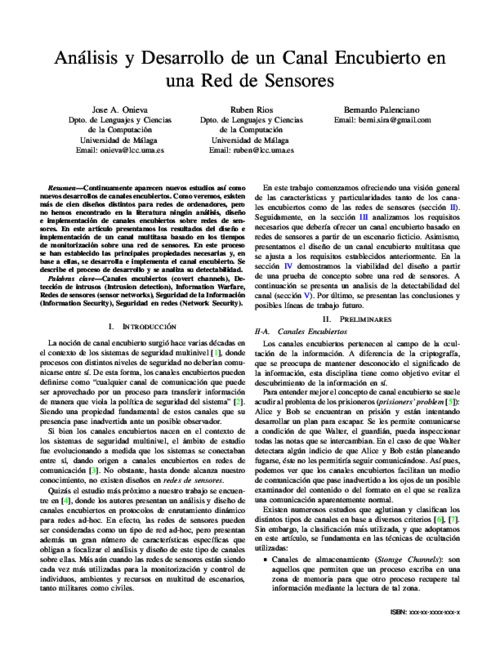
XII Reunión Española sobre Criptología y Seguridad de la Información (RECSI 2012), U.. Zurutuza, R.. Uribeetxeberria, and I.. Arenaza-Nuño Eds., pp. 309-314, Sep 2012.
Abstract
Los patrones de tráfico característicos de las redes inalámbricas de sensores (WSNs) dan lugar al problema de la privacidad de localización. De manera similar, el tráfico de los usuarios en Internet revela información sensible que puede ser protegida mediante sistemas de comunicación anónima (ACS). Por ello, este trabajo analiza la posibilidad de adaptar las soluciones de anonimato tradicionales al problema particular de las redes de sensores. Hasta el momento estas soluciones habían sido rechazadas sin un análisis riguroso, argumentando simplemente que eran demasiado exigentes computacionalmente para los nodos sensores. Nuestros resultados demuestran que, en general, algunos ACS no cumplen los requisitos de privacidad necesarios en WSNs mientras que otros, que si los cumplen, se valen de una cantidad de recursos que superan la capacidad de los sensores.

X Jornadas de Ingeniería Telemática (JITEL 2011), K. Hackbarth, R. Agüero, and R. Sanz Eds., Universidad de Cantabria, pp. 104 - 111, 09/2011.
Abstract
El paradigma de red personal (PN) permitirá la interacción y colaboración del creciente abanico de dispositivos personales. Con tal fin la PN ha de integrar en su seno múltiples tecnologías heterogéneas con diversas capacidades computacionales y de comunicación de forma segura. En particular, la incorporación de la tecnología RFID en objetos personales conlleva múltiples riesgos de seguridad y privacidad que han suscitado un elevado interés de la comunidad investigadora en los últimos años. Más allá de su seguridad de forma aislada, su integración en la PN y la interacción de ésta con redes de área extensa como Internet of Things requieren una arquitectura de red personal adecuada para tal contexto. Este artículo proporciona los fundamentos de tal arquitectura segura incluyendo el análisis de aspectos como la incorporación e inicialización de las restringidas etiquetas RFID en la red personal, la autenticación tanto de miembros de la PN como de usuarios y servicios remotos en su acceso a las tecnologías de contexto, el control de las políticas de privacidad y el establecimiento de canales seguros de comunicación supervisados.
IET Communications, vol. 5, Institution of Engineering and Technology, pp. 2518 - 2532, Nov 2011. DOI
Abstract
Extensive work has been done on the protection of Wireless Sensor Networks (WSNs) from the hardware to the application layer. However, only recently, the privacy preservation problem has drawn the attention of the research community because of its challenging nature. This problem is exacerbated in the domain of WSNs due to the extreme resource limitation of sensor nodes. In this paper we focus on the location privacy problem in WSNs, which allows an adversary to determine the location of nodes of interest to him. We provide a taxonomy of solutions based on the power of the adversary and the main techniques proposed by the various solutions. In addition, we describe and analyse the advantages and disadvantages of different approaches. Finally, we discuss some open challenges and future directions of research.
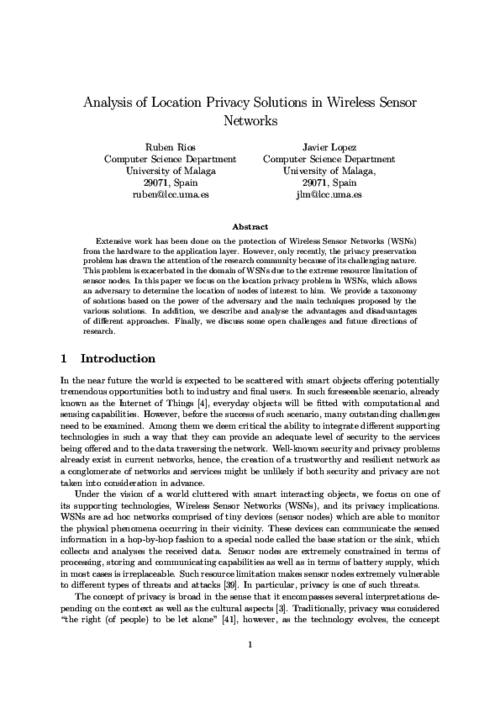
XI Reunión Española sobre Criptología y Seguridad de la Información (RECSI 2010), pp. 337-342, September, 2010.
Abstract
Las Infraestructuras Críticas (ICs) son monitorizadas por sistemas altamente complejos, conocidos como sistemas SCADA (Sistemas de Control y Adquisición de Datos), cuyo principal soporte se encuentra en las subestaciones, las cuales miden de primera instancia el estado real de tales ICs. Para mejorar este control, la industria está actualmente demandando la integración en el modelo tradicional de dos avances tecnológicos: Internet y las redes de sensores inalámbricas. Sin embargo, su incorporación requiere analizar los requisitos de seguridad que surgen en dicho contexto, así como diversos aspectos correlacionados (ej. mantenimiento, rendimiento, seguridad y optimización) y, en base a estos, la estrategia de integración más adecuada para satisfacer dichos requisitos. Este artículo proporciona dicho análisis en profundidad con el fin de ofrecer un modelo de integración seguro adecuado para entornos críticos.
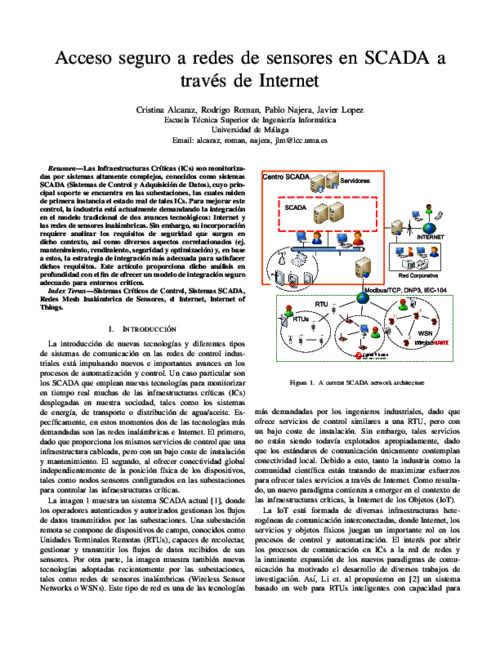
Foundations of Security Analysis and Design 2009, LNCS 5705, Springer Berlin/Heidelberg, pp. 289-338, August, 2009. DOI
Abstract
As sensor networks are more and more being implemented in real world settings, it is necessary to analyze how the different requirements of these real-world applications can influence the security mechanisms. This paper offers both an overview and an analysis of the relationship between the different security threats, requirements, applications, and security technologies. Besides, it also overviews some of the existing sensor network standards, analyzing their security mechanisms.
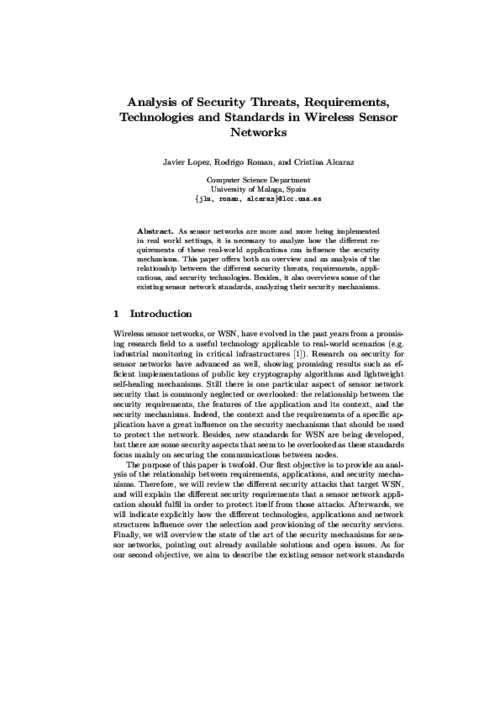
VI Jornadas de Ingeniería Telemática (JITEL’08), pp. 437, September, 2008.
Abstract
Las infraestructuras críticas, como el sector energético, la banca, el transporte, y muchas otras, son un pilar esencial para en bienestar de la sociedad y la economía de un país. Estas infraestructuras dependen a su vez de ciertas infraestructuras de información, las cuales permiten su correcto funcionamiento. La tarea de proteger esas infraestructuras (de información) críticas es compleja y multidimensional, con una gran cantidad de desafíos por resolver. Precisamente, las redes de sensores pueden ser de gran ayuda para esta tarea, debido a suscapacidades de control distribuidas y a su habilidad de funcionar en situaciones extremas. Este artículo analiza la utilidad de las redes de sensores en este contexto, describiendo tanto sus capacidades como sus posibles roles y mecanismos de integración para la protección de infraestructuras (de información) críticas.
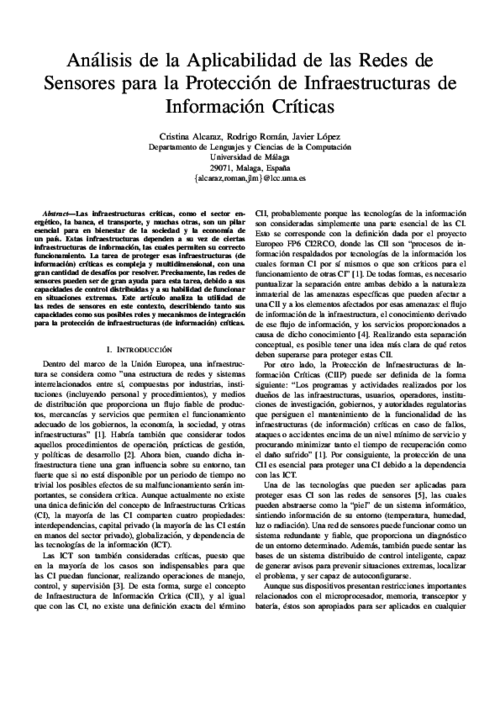
VI Jornadas de Ingeniería Telemática (JITEL’07), pp. 401-408, September, 2007.
Abstract
Security in wireless sensor networks is very limited due to highly-constrained hardware of sensor nodes. To protect services is necessary to use secure foundations, known as security primitives, like part of a protocol. Theses primitives must assure at least confidentiality in the communication channel, authentication of the peers involved in an information exchange, and integrity of the messages. There are many primitives such as symmetric encryption, hash functions and public key cryptography, but not all of them can be supported by sensor nodes since require high resource levels, for example memory. This paper contains a deep analysis of available and suitable security primitives for sensor nodes, as well as an analysis of hardware and software implementations. Besides, it has been developed an experiment with two implementations, and it has been created a new and improved version using the optimizations of each.
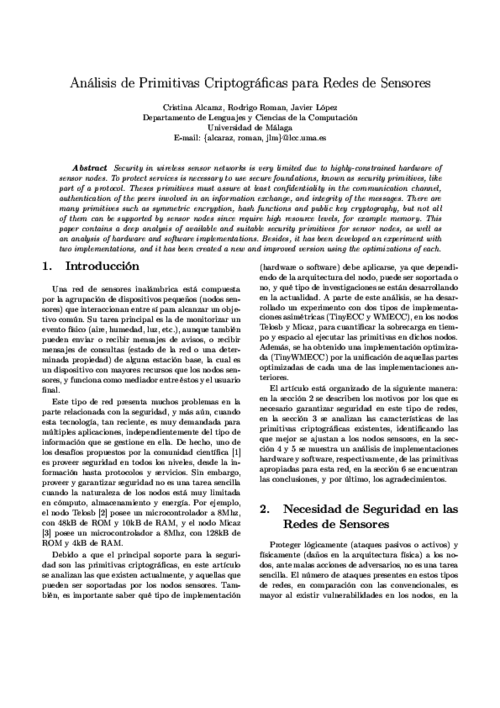
European PKI Workshop: Theory and Practice (EuroPKI’07), LNCS 4582, Springer, pp. 313-320, June, 2007. DOI
Abstract
Wireless Sensor Networks (WSN) are becoming a key technology in the support of pervasive and ubiquitous services. The previous notion of PKC is too expensive for WSN has changed partially due to the existence of new hardware and software prototypes based on Elliptic Curve Cryptography and other PKC primitives. Then, it is necessary to analyze whether it is both feasible and convenient to have a Public Key Infrastructure for sensor networks that would allow the creation of PKC-based services like Digital Signatures.
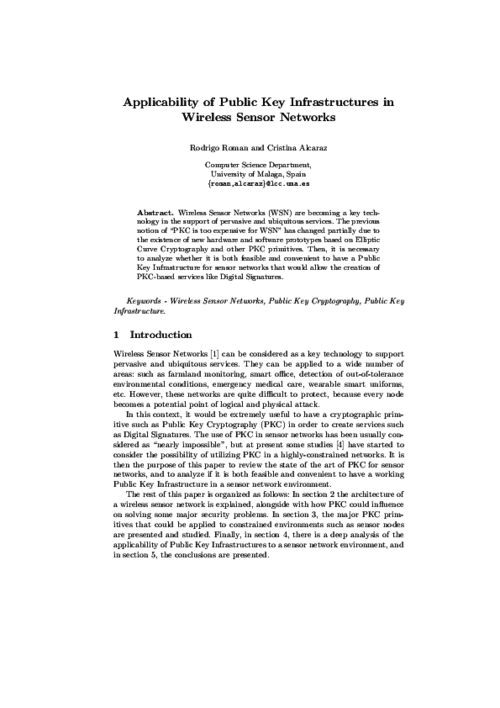
IEEE Consumer Communications & Networking Conference (CCNC 2006), IEEE, pp. 640-644, January, 2006. DOI
Abstract
The research of Intrusion Detection Systems (IDS) is a mature area in wired networks, and has also attracted many attentions in wireless ad hoc networks recently. Nevertheless, there is no previous work reported in the literature about IDS architectures in wireless sensor networks. In this paper, we discuss the general guidelines for applying IDS to static sensor networks, and introduce a novel technique to optimally watch over the communications of the sensors’ neighborhood on certain scenarios.
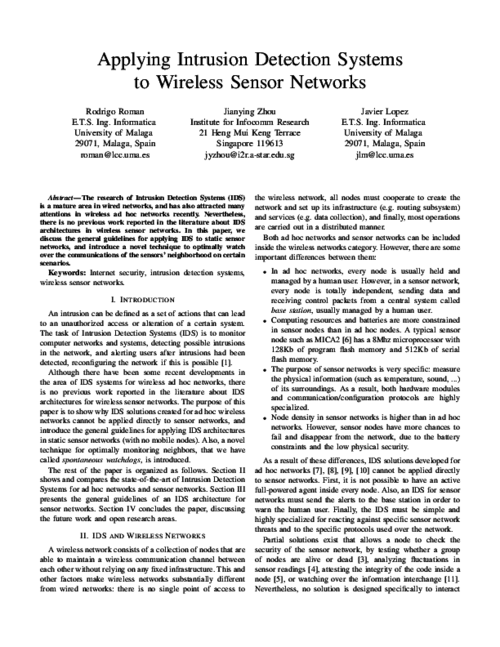
1st International Workshop on Critical Information Infrastructures Security (CRITIS’06), LNCS 4347, Springer Berlin / Heidelberg, pp. 166-178, 2006. DOI
Abstract
It is commonly agreed that Wireless Sensor Networks (WSN) is one of the technologies that better fulfills features like the ones required by Critical (Information) Infrastructures. However, a sensor network is highly vulnerable against any external or internal attacks, thus network designers must know which are the tools that they can use in order to avoid such problems. In this paper we describe in detail a procedure (the KMS Guidelines), developed under our CRISIS project, that allows network designers to choose a certain Key Management System, or at least to know which protocol need to improve in order to satisfy the network requirements.
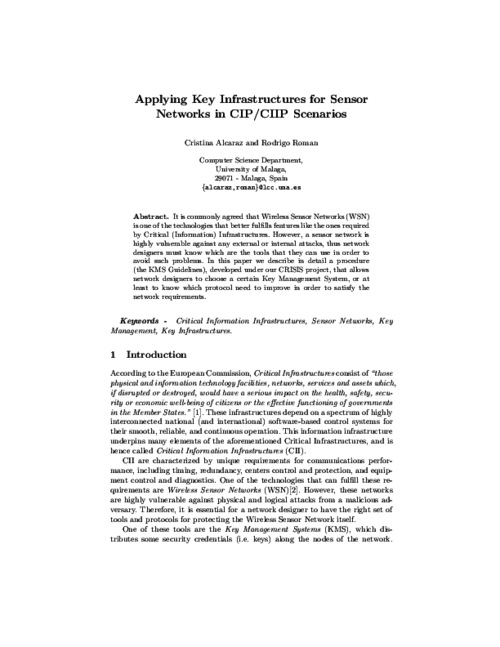
V Jornadas de Ingenería Telemática (JITEL’05), pp. 335-343, Septiembre, 2005.
Abstract
The design and development of security infrastructures and protocols for Wireless Sensor Networks is a difficult task, due to several factors like the constraints of the sensor nodes and the public nature of the communication channels. The intrinsic features of these networks create numerous security problems. In this paper, we analyze and put into perspective those problems.
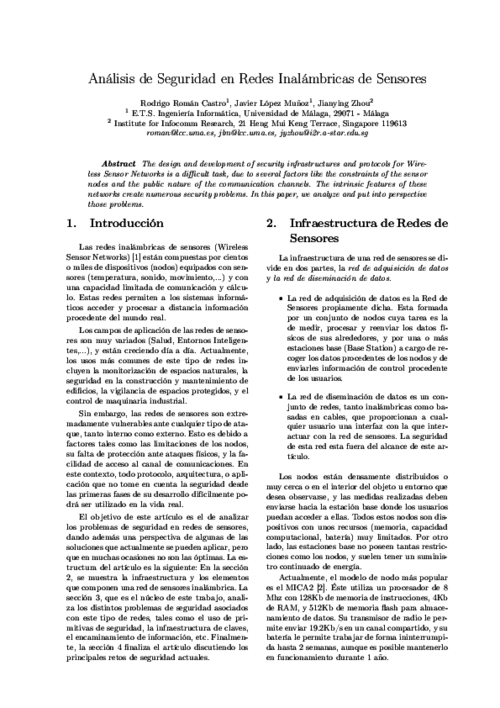
Simposio sobre Computación Ubicua e Inteligencia Ambiental (UCAmI’05), pp. 113-120, September, 2005.
Abstract
Los sistemas de detección de intrusiones (IDS) son una herramienta imprescindible de seguridad a la hora de proteger una red. Recientemente se han investigado y desarrollado arquitecturas de IDS para redes inalámbricas, en concreto para redes "Ad Hoc". No obstante, no existe un trabajo previo que desarrolle una arquitectura de IDS para una red de sensores. En este artículo, analizamos porque los sistemas IDS de redes "Ad Hoc" no pueden aplicarse a redes de sensores, e introducimos una arquitectura de IDS para redes de sensores que incorpora una nueva técnica para vigilar las comunicaciones de la red en ciertos escenarios.
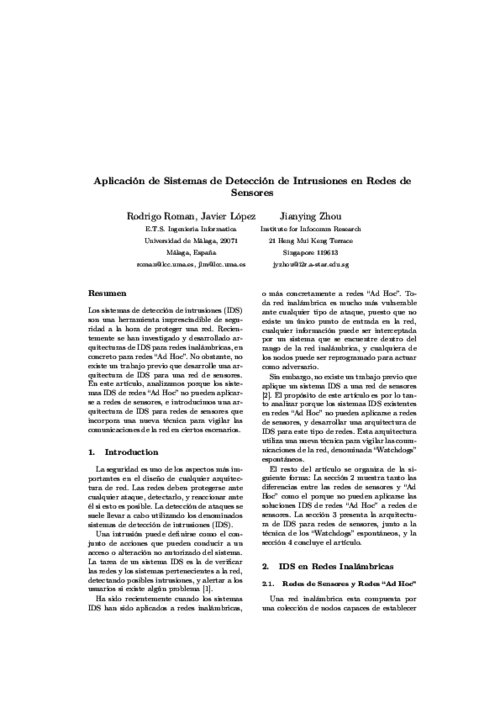
25th Conference on Artificial Intelligence (KI’02), LNAI 2479, Springer, pp. 235-249, September, 2002.
Abstract
Clausal temporal resolution is characterised by a translation of the formulae whose satisfiability is to be established to a normal form, step resolution (similar to classical resolution) on formulae occurring at the same states and temporal resolution between formulae describing properties over a longer period. The most complex part of the method occurs in searching for candidates for the temporal resolution operation, something that may need to be carried out several times. In this paper we consider a new technique for finding the candidates for the temporal resolution operation. Although related to the previously developed external search procedure, this new approach not only allows the temporal resolution operation to be carried out at any moment, but also simplifies any subsequent search required for similar temporal formulae. Finally, in contrast with previous approaches, this search can be seen as an inherent part of the resolution process, rather than an external procedure that is only called in certain situations.} year = {2002
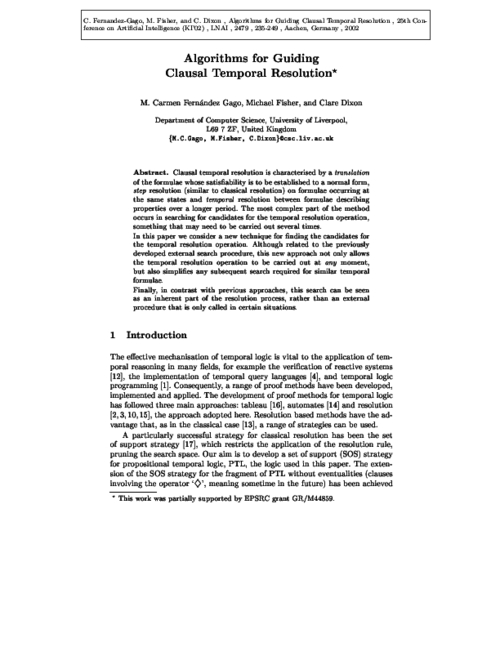
 ]
]